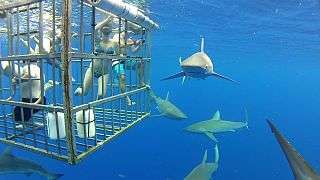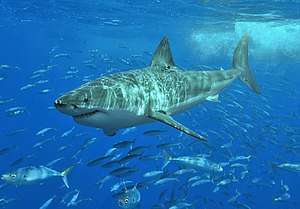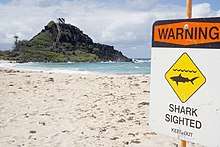Shark tourism
Shark tourism is a way for tourists to see sharks the ocean rather than in an aquarium. It is a form of eco-tourism intended to show in that local shark species are more valuable alive than dead. Instead of opting for a one time economic benefit of harvesting sharks for their body parts, communities are enabled to assist tourists who want to see live sharks. People can get close to the sharks by free- or scuba diving or entering the water in a protective cage.

Categories
Species commonly seen in shark tourism activities include
- Great white sharks - mainly surface viewing in cages[1]
- Tiger, bull, oceanic whitetip, and other less aggressive (but potentially dangerous) sharks - in the pelagic zone
- Sand tiger sharks, which tend to congregate on certain reefs and wrecks at specific times of the year
- Basking and whale sharks - harmless plankton feeders
Great white shark

Great white shark viewing is available at the Neptune Islands in South Australia,[2] South Africa, Isla Guadalupe in Mexico, and New Zealand. Great white sharks are usually viewed using shark cages to protect the diver. Because of the exceptional visibility underwater in Isla Guadalupe, more outside the cage diving is done than anywhere else.[3]
The great white shark viewing industry was founded in the 1970s by pioneer Australian diver and great white attack survivor Rodney Fox in South Australia. He was the sole world-wide operator until the South African industry was founded in early 1989 by Pieter van der Walt who was joined shortly thereafter by pioneer diver and underwater photographer George Askew who handled promotions and put South African cage diving "on the map" with the publicity he got - until they split in Jan 1992, after they, together with famous Australian divers, Ron and Valerie Taylor, did the world's first dive amongst great white sharks without a cage and completely unprotected.[4]
This dive was directly responsible for the upsurge in shark tourism – especially free-diving (i.e. out of cage) swimming with big sharks. When operators around the world became aware that the great white was quite approachable and not likely to attack they considered whether the other sharks with bad reputations like Tigers, Bulls and Oceanic's might be safe enough to swim with too. This proved to be the case and shark tourism has become a multi-million-dollar a year industry.[5] In attempts to protect the great white shark species, in some places such as South Australia, there is mandatory logbook reporting and photograph/identification required to monitor how cage-diving tourism may impact white sharks involved in these tourism interactions.[6]
Tiger, bull and oceanic white tip
The Bahamas is a favorite region for pelagic sharks. Divers in the Bahamas experience reef sharks and tiger sharks while they are hand-fed. Isla Guadalupe, Mexico has been named a Biosphere Reserve in an effort to control the shark diving activities there. Although the practice of shark diving proves to be controversial, it has been proven very effective in attracting tourists. Whale sharks, while not traditionally harvested for their fins but are sometimes harvested for their meat, have also benefited from shark tourism because of snorkelers getting into the water with the gentle giants. In the Philippines snorkelers must maintain a distance of four feet from the sharks and there is a fine and possible jail time for anyone who touches the animals.[7]
Several shark species are known from shark feeding dive sites within the Pacific Region. Grey reef sharks are the main feeders in places such as the Great Barrier Reef, Micronesia and Tahiti. Silvertips and Black Tips Reef Sharks tend to be more seen around the Papua New Guinea coastlines. Bull sharks are found around Mexico, Playa del Carmen in particular.[8]
Whale Shark
Whale sharks attract a large amount of tourists each year to South Ari Atoll in the Republic of Maldives, yet, there is still some ambiguity regarding the economic extent of the attraction of these animals. Thus, making conservation/ implementation of management methods difficult to conduct.[9]
Additionally, whale sharks in the waters of the small town of Oslob, on Cebu islands in the Philippines, The sharks have become a top tourist attraction, local governments in the Philippines have followed along in the legalization of feeding these animals in attempt to attract more tourists. Although a huge commercial success, there is growing concern for the implementation of regulation and protection for the whale sharks and its marine environment.[10]
The coral reefs in the Philippines are being harmed greatly by the overpopulation of sharks and people in the area. As the population increases immensely so does the opportunity for the coral reefs to diminish. Sharks are overpopulating because they are being fed by tour operators and it is attracting many more sharks to the area than there naturally would be. This is causing the sharks to be more aggressive with people because they are getting too comfortable with people because they are associating feeding time with the people that are tossing the food to them.
Free Diving
This type of shark tourism is done by professionals that dive down with the individuals that are partaking in the tourism event. A diver takes a small group of people down approximately 40 meters deep where the shark actions takes place. Often sharks do not pay much attention to the divers, but in rare cases when there are threatening times the operator uses his/her training skills to prevent an attack from occurring.
Ningaloo Marine Park
Ningaloo Marine Park in Western Australia is the site of an annual whale shark aggregation. This site is a very popular tourist site, as whale sharks are incredibly gentle creatures that pose very little threat to humans. Introduced in 1997 and revised to its current version in 2013, the Department of Parks and Wildlife is responsible for a whale shark management program designed to protect the whale shark species and regulate human interaction with them.[11]
Licensing
The shark tourism industry is meant to educate and increase awareness of the natural environment as well as generate profits for the local people. Data from the years 2006 to 2010 on whale sharks at Ningaloo Reef, Western Australia, has been evaluated to determine the scale of the tourism operations and the spatial and temporal distribution of interactions between whale sharks and humans; for example: whale shark tours at Ningaloo increased by about 70%.[12] The whale shark management program of Ningaloo Marine Park relies on the Conservation and Land Management Act of 1984 (CALM Act) and the Wildlife Conservation Act of 1950. The CALM Act requires tour operators to obtain a commercial tourist activity licence, and the Wildlife Conservation Act requires a wildlife interaction licence for each protected species a tour may come in contact with. This includes the whale sharks but is not limited to whales, other shark species, and dugongs.[13] Under these laws, the Western Australian government is able to regulate how tourists interact with whale sharks and to what extent. A maximum of 15 operators are allowed to obtain licences at a given time. In addition, only one tour vessel is allowed to travel to the whale sharks while the rest must stay 250 metres away. Only ten swimmers are allowed in the water at a time, which controls the crowding of the area, and tourists are prohibited from feeding or touching the whale sharks.[14]
Conservation
Whale sharks are considered a vulnerable species and have been targeted by fishermen for many years. In Ningaloo Marine Park, they are entirely protected.[15] The whale sharks in the area are considered highly valuable in the ecotourism industry, as the industry provides numerous jobs to local people and brings in US$12 million annually. Tourist interest in wildlife tourism continues to grow, and the whale shark tourism industry is expected to increase through the year 2020.[16]
Economic Valuation of Whale Shark Tourism
Previous economic valuation of whale shark tourism (in US million dollars).
Valuations reported in other currencies were converted to US$ using the average official rate for the year of 2007.
| Location
(season duration) |
Year | Total
expenditure |
Expenditure on
WS excursions |
Method | Reference |
| Belize (6 wks) | 2002 | $3.7 | – | Direct spend | Graham (2003) |
| Seychelles (14 wks) | 2003 | – | $1.2 | Contingent | Cesar et al. (2004) |
| 2007 | $3.9–5.0 | – | Direct spend | H Newman et al.,
2007, unpublished dataa | |
| Ningaloo (9 wks) | 1994 | $4.7 | $1.0 | Direct spend | Davis et al. (1997) |
| 2004 | $13.3 | – | Unknown | Norman (2005) | |
| 2006 | $4.5 | $2.3 | Direct spend | Catlin et al. (2010b) | |
| 2006 | $1.8–3.5 | – | Substitution value | Catlin et al. (2010b) |
Conservation benefits
Passive and active forms of shark tourism are believed to conserve the species by generating commercial value to their lives in the natural world. In North Carolina wreck divers regularly visit the World War II shipwrecks to dive with the Sand Tiger sharks that make the wrecks their home.[18] The shark tourism industry conducted a search, using a global questionnaire; detecting that 42% of operators conducting shark tourism used an attractant to lure sharks, and that 93% of operators surveyed regulated their practices using codes of conduct.[19]
Business Related to Shark Tourism
Shark tourism opened up a beneficial economic opportunity all over the globe. This helps the poverty stricken areas of the Bahamas, Moorea, Maldives, Australia and many more places around the globe. The only things needed for shark tourism to take place is sharks, which are found almost everywhere in the oceans encompassing the world. Shark tourism is positively impacting the lives of many, as conductors are making good money to take the people down into the water to view the sharks and the people are paying big money to do just this.Tourism providers often provide food to attract sharks to areas where they can be more easily viewed, although this is controversial.[20] In Australia's Great Barrier Reef Marine Park and the states of Hawaii and Florida shark feeding is prohibited.[21] Hawaii had several issues with the banning of shark feeding. The initial law that prohibited it was passed in 2002, but many locals realized the tour companies were not following this law and pushed for stricter enforcement.[22]
Shark tourism in Hawaii

Sharks, or "mano" as they are called by the local Hawaiians, are viewed as sacred. Early Hawaiians worshiped and protected the sharks which they saw as family gods or "aumaka".[23] In recent years, shark cage diving has become a very profitable tourist attraction in the state. Native Hawaiians were not pleased with this at first due to the fact that the companies were luring in the sharks using bait; they viewed these animals as sacred and feeding them for entertainment was said to be unjust.[24] There was also speculations that by feeding them, the sharks would begin to associate the boats and humans with food. For this reason, a bill was passed in Hawaii in 2002 that banned the feeding of sharks in state waters, which is about 3 miles off shore.[25]
Shark Tourism in Fiji
Beqa Lagoon is home to eight species of sharks, each of which are very prominent around feeding sites. Shark diving and shark feeding is very popular in the area, locals have been swimming with the sharks for close to three thousand years. The local people have many myths about these creatures passed down from antiquity. They are easily spotted in the waters of Beqa Lagoon Resort, which is their primary feeding ground. Shark tourism in places such as this is very profitable in Fiji, generating around US$42 million. [26]
Shark Tourism in Palau
Palau is home to three species of sharks; the grey reef shark, the leopard shark, and the whitetip reef sharks. Palau's waters have many coral reefs, which are home to grey reef sharks, the most commonly seen of the three. Whitetip reef sharks are also seen around coral reefs, and are much more curious than the other sharks. Many tourists and locals are fascinated by these creatures, so that shark diving has become a big part of many tourists incentive to go to Palau. Studies have shown that shark diving and shark tourism in general is a major contributor to the economy of Palau. Over US$18 million is generated every year, which accounts for close to 10% of all domestic product in the country. The local communities and government benefit, receiving over $1 million and US$1.5 million respectively.
Special interest groups
Many people are involved in interest groups such as the late iDive Sharks Network[27] that aim to celebrate and promote safe and responsible shark diving activities.[28]
References
- Shark Tourism (December 2013), White Shark Ecoventures, Shark Tourism, p. 1, archived from the original on 2014-05-06
- "Shark cage diving". Department of Environment, Water and Natural Resources. Retrieved 12 December 2013.
- Ward, Terry. "Diving with the Great White Sharks of Guadalupe Island". AOL Travel. Retrieved 20 August 2015.
- David Seifert, Douglas. "A tribute to Ron Taylor". sharksavers.org. Retrieved 20 August 2015.
- "Ecotourism: Dollars and Sense". sharksavers.org. Retrieved 16 August 2015.
- Nazimi, Leila; Robbins, William David; Schilds, Adam; Huveneers, Charlie (June 2018). "Comparison of industry-based data to monitor white shark cage-dive tourism". Tourism Management. 66: 263–273. doi:10.1016/j.tourman.2017.12.002.
- Cannon, Marisa (2015-07-06). "Swimming with whale sharks in the Philippines". cnn.com. CNN. Retrieved 16 August 2015.
- Van Der Haar, Nils (2013-03-22). "Why not to Bull Shark Dive in Play Del Carmen". Scuba Diver Life. Retrieved 20 August 2015.
- Cagua, Edgar Fernando; Collins, Neal; Hancock, James; Rees, Richard (12 August 2014). "Whale shark economics: a valuation of wildlife tourism in South Ari Atoll, Maldives". PeerJ. 2: e515. doi:10.7717/peerj.515. PMID 25165629.
- "Rationalize the whale shark tourism in the Philippines for a better protection and a sustainable activity for local communities — Universite Cote d'Azur".
- Parks and Wildlife, Department of (October 2013). "Whale shark management with particular reference to Ningaloo Marine Park" (PDF). www.dpaw.wa.gov.au. Retrieved August 5, 2017.
- Anderson, Douglas J.; Kobryn, Halina T.; Norman, Brad M.; Bejder, Lars; Tyne, Julian A.; Loneragan, Neil R. (July 2014). "Spatial and temporal patterns of nature-based tourism interactions with whale sharks (Rhincodon typus) at Ningaloo Reef, Western Australia". Estuarine, Coastal and Shelf Science. 148: 109–119. Bibcode:2014ECSS..148..109A. doi:10.1016/j.ecss.2014.05.023.
- Techera, Erika J.; Klein, Natalie (2013). "The Role of Law in Shark-Based Eco-Tourism: Lessons from Australia". Marine Policy. 39: 21–28. doi:10.1016/j.marpol.2012.10.003.
- Davis, Derrin (1998). "Whale Shark Tourism in Ningaloo Marine Park, Australia". Anthrozoos: A Multidisciplinary Journal of the Interactions of People & Animals. 11 (1): 5–11. doi:10.2752/089279398787000850.
- "Discover the Whale Shark!". IUCN Red List 50. 2014-07-23. Retrieved 2017-08-06.
- "Global economic value of shark ecotourism: Implications for conservation (PDF Download Available)". ResearchGate. Retrieved 2017-08-06.
- Rowat, David; Engelhardt, Udo (March 2007). "Seychelles: A case study of community involvement in the development of whale shark ecotourism and its socio-economic impact". Fisheries Research. 84 (1): 109–113. doi:10.1016/j.fishres.2006.11.018.
- Decker, Robert. "Ghosts in the Graveyard: N.C. Shark Diving". ScubaDiving.com. Retrieved 17 June 2015.
- Richards, Kirsty; O’Leary, Bethan C.; Roberts, Callum M.; Ormond, Rupert; Gore, Mauvis; Hawkins, Julie P. (February 2015). "Sharks and people: Insight into the global practices of tourism operators and their attitudes to Shark behaviour". Marine Pollution Bulletin. 91 (1): 200–210. doi:10.1016/j.marpolbul.2014.12.004. PMID 25577473.
- Higham, James; Lück, Michael (2008). Marine Wildlife and Tourism Management: Insights from the Natural and Social Sciences. CAB International. p. 58. ISBN 978-1-84593-345-6.
- Great Barrier Reef Marine Park Authority. "Environmental Status: Sharks and rays: Response: tourism". Archived from the original on 2011-04-11. Retrieved 2013-07-10.
- "Hawaii's shark tours persist despite laws against feeding - Mauinews.com | News, Sports, Jobs, Visitor's Information - The Maui News". mauinews.com. Archived from the original on 2016-06-02. Retrieved 2016-05-06.
- "The Honolulu Advertiser - Island Life". the.honoluluadvertiser.com. Retrieved 2016-05-03.
- Taylor, Leighton R. (1993-01-01). Sharks of Hawaii: Their Biology and Cultural Significance. University of Hawaii Press. ISBN 9780824815622.
- "Global Law and Regulation". policy.mofcom.gov.cn. Retrieved 2016-05-03.
- Object, object. "Shark diving in Fiji's Beqa Lagoon". Lonely Planet. Retrieved 2019-10-22.
- "The Inglorious End of iDive Sharks?". Shark Diver. 2011-07-17. Retrieved 26 August 2015.
- Zenato, Christina. "Shark Diving, Shark Feeding, and Common Sense". sharksavers.org. Retrieved 26 August 2015.
External links
- Scuba divers swim among the sharks, Fayetteville Observer
- Sand Tigers Video